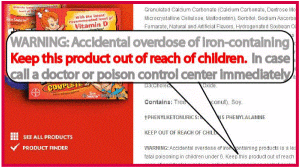The #1 Children’s Vitamin Brand in th e US contains ingredients that most parents would never intentionally expose their children to, so why aren’t more opting for healthier alternatives?
e US contains ingredients that most parents would never intentionally expose their children to, so why aren’t more opting for healthier alternatives?
Kids vitamins are supposed to be healthy, right? Well then, what’s going on with Flintstones Vitamins, which proudly claims to be “Pediatricians’ #1 Choice”? Produced by the global pharmaceutical corporation Bayer, this wildly successful brand features a shocking list of unhealthy ingredients, including:
- Aspartame
- Cupric Oxide
- Coal tar artificial coloring agents (FD&C Blue #2, Red #40, Yellow #6)
- Zinc Oxide
- Sorbitol
- Ferrous Fumarate
- Hydrogenated Oil (Soybean)
- GMO Corn starch
For years I have worked in my private practice to support patients who, in the past, have gone through bariatric surgery. Flinstones Vitamins are THE recommended supplement for this patient population. This is coming directly from their doctors. If you don’t believe me, take a moment to search ‘bariatric surgery + flinstones vitamins.’ Flinstones are not a healthy option for this population, or our children.
On Bayer Health Science’s Flintstones product page designed for healthcare professionals they lead into the product description with the following tidbit of information:
82% of kids aren’t eating all of their veggies1. Without enough vegetables, kids may not be getting all of the nutrients they need.
References: 1. Lorson BA, Melgar-Quinonez HR, Taylor CA. Correlates of fruit and vegetable intakes in US children. J Am Diet Assoc. 2009;109(3):474-478.
The implication? That Flintstones vitamins somehow fill this nutritional void. But let’s look a little closer at some of these presumably healthy ingredients….
ASPARTAME
Aspartame is a synthetic combination of the amino acids aspartic acid and l-phenylalanine, and is known to convert into highly toxic methanol and formaldehyde in the body. Aspartame has been linked to over 40 adverse health effects in the biomedical literature, and has been shown to exhibit both neurotoxicity and carcinogenicity What business does a chemical like this have doing in a children’s vitamin, especially when non-toxic, non-synthetic non-nutritive sweeteners like stevia already exist?
CUPRIC OXIDE
Next, let’s look closer at Cupric Oxide, 2mg of which is included in each serving of Flinstone’s Complete chewable vitamins as a presumably ‘nutritional’ source of ‘copper,’ supplying “100% of the Daily Value (Ages 4+), according to Flintstones Vitamins Web site’s Nutritional Info.
But what is Cupric Oxide? A nutrient or a chemical?
According to the European Union’s Dangerous Substance Directive, one of the main EU laws concerning chemical safety, Cupric Oxide is listed as a Hazardous substance, classified as both “Harmful (XN)” and “Dangerous for the environment” (N). Consider that it has industrial applications as a pigment in ceramics, and as a chemical in the production of rayon fabric and dry cell batteries. In may be technically correct to call it a mineral, but should it be listed as a nutrient in a children’s vitamin?
COAL TAR ARTIFICIAL COLORING AGENTS
A well-known side effect of using synthetic dyes is attention-deficit hyperactivity disorder. For direct access to study abstracts on this topic view our Food Coloring research page. There is also indication that the neurotoxicity of artificial food coloring agents increase when combined with aspartame,[3] making the combination of ingredients in Flintstones even more concerning.
ZINC OXIDE
Each serving of Flinstones Complete Chewable vitamins contain 12 mg of zinc oxide, which the manufacturer claims delivers 75% of the Daily Value to children 2 & 3 years of age. Widely used as a sun protection factor (SPF) in sunscreens, The EU’s Dangerous Substance Directive classifies it as an environmental Hazard, “Dangerous for the environment (N).” How it can be dangerous to the environment, but not for humans ingesting it, escapes me. One thing is for sure, if one is to ingest supplemental zinc, or market it for use by children, it makes much more sense using a form that is organically bound (i.e. ‘chelated’) to an amino acid like glycine, as it will be more bioavailable and less toxic.
Enjoying this content? Sign up for updates... It's FREE!




Comments
from 1 people
Leave A Comment